关于游戏心理恐怖境遇氛围营造的系列分析(续篇)
篇目5,以神经系统科学原理分析恐怖游戏设计要素
恐惧是人类的本能。它不仅能够帮助我们在危险境况中获得生存,同时它在娱乐产业中的运用也可以带给我们受惊吓的乐趣。电子游戏产业便通过利用人们的这种情感,并将其融入游戏故事和设计中而创造出许多优秀的恐怖游戏。
例如我们可以将玩家放置在一个资源短缺的危险环境中,并且他们需要在此面对各种敌人。设置合理的话,玩家将会心跳加速,手心冒汗,甚至连在晚上睡觉时都会做恶梦!而如果设置不够合理,玩家便只会觉得他们在“走过场”而已。
在过去的20年,一些游戏因为能够成功带给玩家恐惧与紧张感而被定义为恐怖求生游戏(游戏邦注:包括早前的《生化危机》系列,以及最近的《失忆症:黑暗后裔》)。
尽管经过多次成功的迭代,这些游戏都提供了许多不同的敌人,游戏机制和情节,但是对于玩家心理的影响却始终保持不变。本文将着重阐述游戏产业是如何使用人类的这种恐惧心理,并研究如何平衡恐惧与游戏玩法而最终创造出一款成功的游戏。
关于恐惧的科学解析
先是焦虑,然后才开始害怕。焦虑总是我们在电子游戏中最先感受到的。如果说恐惧是对于逼近的威胁的反应,那么焦虑便是对于未来潜在威胁的反应。
人类都带有感知系统,并且根据研究表明,当危险慢慢逼近时,人类便会产生一种焦虑感,并且面向这一潜在危险而提高自己的注意力和敏感度。这就意味着当玩家在游戏中解决一个谜题时他们同时也在感受着恐惧与危险。根据很多玩家的表述,当他们在一个危险的环境下解决谜题时,他们的恐惧感也会随之上升。《寂静岭》便非常擅于通过谜题去突出这种恐惧。
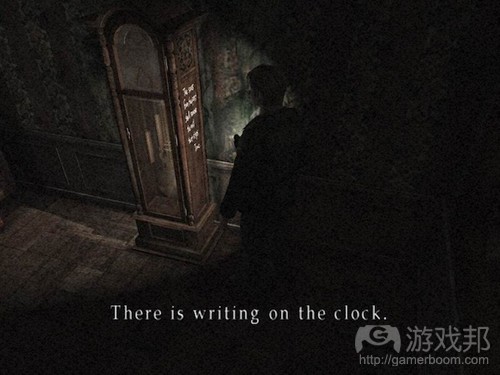
寂静岭2(from gamasutra)
(这是《寂静岭2》中的一个谜题,玩家需要在一个黑暗且破旧的房间中做出解答。)
尽管第一人称射击游戏总是降低了玩家对暴力的敏感度,但是这类型游戏却能够带给玩家面对危险的焦虑。这是一种动物反应行为,并且是一种高度自适应行为,因为它将确保个人能够在一种危险的环境下保持高度警惕。也就是在电子游戏中提升焦虑感便能够帮助玩家更加敏感地面对游戏中的危险。在像《失忆症》等游戏中,整个游戏体验都让玩家笼罩在焦虑中(并且玩家也并不清楚如何保护自己),从而帮助他们更好地应对敌人的攻击。
无助。就像之前所提到的,玩家在生存恐怖游戏中总是会面临一些可怕且不可避免的环境,同时也缺少足够的自我防御措施。换句话说,他们总是会在此面临极端无助的境况。
在《失忆症》中,玩家总会记得将自己锁在壁橱中,或隐藏在角落里长时间盯着空白的墙壁,因为他们知道如果自己移动了(甚至只是一小步),便可能会面临致命的恐怖袭击。除此之外,僵硬的摄像机镜头,笨拙的控制机制(就像《寂静岭》,早前的《生化危机》系列游戏)等元素都有可能剥夺玩家仅拥有的一点控制。
无助是一种非常强大的感受。研究表明,当任何动物在面对让它们倍感无助的环境下总是会产生强烈的恐惧与焦虑。就像是我们去看牙医时的感受。当我们感到无助与失控时,我们必然也会感到焦虑与害怕。在电子游戏中亦是如此。
启动效应。在心理学中,启动效应便是我们对于任何外部刺激所做出的反应。
让我们以低频词汇测试任务为例。在这里,测试对象将面对某些单词,其中有个单词是“lettuce”。然后他便需要填满“let____”。而当测试对象因为之前在实验中看过这个单词而能够准确填出后面的“tuce”时,他便会产生这种启动效应。
很多游戏便是使用这一策略去创造游戏中的焦虑感,即通过使用音效去提醒玩家注意入侵的敌人。在《失忆症》中,当玩家进入各种酷刑室中面对着一个个可怕的受刑犯,他便会产生启动效应,即当他也被锁在这里时,他便会幻想自己将遭到相同的折磨。

《失忆症:黑暗后裔》的酷刑室中的吊刑刑具(from gamasutra)
除了这种启动效应,一些不可预见的事物也会让玩家受到惊吓。例如当玩家因为某些事件而安全地穿越游戏关卡时,他们便会在再次面临相同环境时放下所有防备(游戏邦注:例如《毁灭展示3》的前三十分钟或《寂静岭》和《死亡空间》系列的中心)。
这种方法不仅能够帮助我们节省关卡设计时间,同时也能够维持游戏的进程并创造出一种紧张恐怖的氛围。
镜像神经元。镜像神经元是动物大脑的某一块区域中的神经元,当动物在执行某一行动或观察别人如何执行同一行动时这一神经元便会被触动。
早在几十年前,这种神经元就被当成人们理解别人的目的,感受,情感,甚至是效仿他人行为的关键因素。所以镜像神经元在连接人类经历与虚拟角色中起着非常重要的作用。
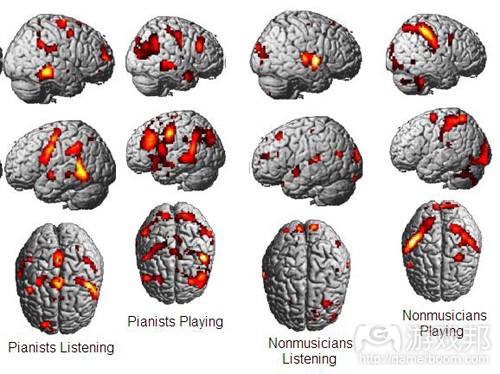
PET研究(from gamasutra)
(根据PET的研究,我们知道大脑中的相同集群总是会因为个人在观看一种行动(听音乐)或参与行动(演奏音乐)时被激发。)
在大多数电子游戏中,当玩家在三维空间中移动时便会触发出空间定向镜像神经元。在《寂静岭》游戏系列中,相同的游戏机制(如玩家需要将手伸到洞里拿出东西或需要将某样东西从马桶中取出来)将能同时引起玩家的焦虑与恶心之感。
就像在《寂静岭2》中,游戏要求James Sunderland必须将手伸到肮脏的马桶里,这便会让玩家感到恶心,并且这种感受也将映射到他的大脑中,并在某种类似情况下再次表现出来。
类似的情况也出现在《死亡空间2》中,即玩家必须选择在一个极端有限的空间中爬行(摄像机镜头让整个画面都变得有所不同)或者需要将针插进Isaac Clarke(游戏邦注:《死亡空间》的主角)的眼睛中。
最好的情况便是,这些游戏的开发者越来越意识到这一元素的重要性,并更加重视它的使用。就像Frictional Games(《失忆症:黑暗后裔》的开发商)的创始人Thomas Grip所言,当游戏拥有较强的移情元素时,添加镜像神经元便非常重要。换句话说,玩家将真正与游戏主角融为一体。
环境。环境对于人们在认知恐惧并加强吃惊反应中起着非常大的作用。在适当的环境下,我们基本的惊吓感将随着厌恶条件的作用(与玩家相对抗)而逐渐发生变化。
环境同时作用于游戏内部和外部。在游戏外部,气氛能够加强玩家的游戏体验(就像在一个黑暗的房间,带上耳机玩游戏更能让玩家有身临其境之感)。而在游戏内部创造一个合适的环境也非常重要,并且能够有效地利用人类的神经生物学原理。例如我们对于黑暗的恐惧是源于不断进化的日夜节律,即白天与黑夜的循环让我们在夜晚显得较为脆弱。同样的,夜间活动的动物如老鼠在见到光时也会常常呈现出类似的惊吓反应。
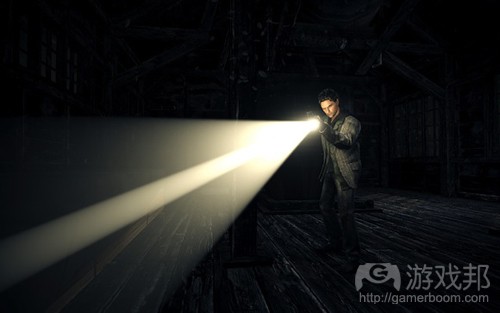
心灵杀手(from gamasutra)
(光线的运用也能够创造出一种无助感,通过将玩家笼罩在一个神秘的环境下能够营造出恐怖的气氛。)
同时还需要指出的是,适当的环境设置也能让我们因为一些不是很危险的物体或线索而诱发出恐惧感。基于听觉线索(而非直接的厌恶刺激)的恐怖环境也能引起玩家的焦虑。
《F.E.A.R.》的反派角色Alma便是一个典型的例子——这个小女孩能够做一些非常可怕的事。此外,不可预测的厌恶刺激(如小女孩与带有电锯的男人之间的对抗)也会增强我们的认知焦虑和恐惧。
《F.E.A.R.》的游戏设计师Craig Hubbard说道:“一个带着面具且手持切肉刀的男人追赶着一名女学生听起来很可怕,但是当你从自己的角度进行思考时,你有可能会想自己至少可以伺机踹这个男人的屁股。而如果这个怪异的小女孩是美国特种部队中的一员,你又该如何处理这种情况?”
将恐怖元素融入游戏玩法中
在恐怖游戏中同时创造出恐惧感与互动性并不是件易事。当其它游戏是在挑战玩家解决谜题与对抗敌人的能力时,恐怖求生游戏则是在挑战玩家对于危险的反应。为了创造出一款优秀的恐怖游戏,你就必须仔细考虑如何基于环境以及角色在环境中的目的而带给玩家焦虑感,有效地连接游戏环境与角色间的关系,并除玩家所拥有的控制权。
而这种设计也有可能创造出一种事先设定好的恐惧感(即在《寂静岭2》中,Pyramid Head幽灵般的外观便分散于游戏的各个角落),这将让玩家察觉到游戏的线性玩法,而让他们难以在此感受到个性化的体验/选择,并认为游戏不具有重完价值。

Pyramid Head(from gamasutra)
(上图:在《死亡空间》中当玩家首次遭遇尸变体时他们并不能给予反击从而提升了焦虑感。下图:Pyramid Head透过一个不能通过的铁栏凝视着James Sunderland。)
这同时也将在玩家的游戏过程中创造出一种不可预期感。就像在《寂静岭:破碎的记忆》中便出现了一些特定的事件以暗示游戏向“冰雪世界的过度”,而推动玩家为了避开危险奋力奔跑。
但是这种事件只能创造出一次的焦虑感,之后再尝试也就不见得有效了。但是这却不意味着这种事件不再能够引起玩家的焦虑,它只是达不到之前的效果罢了。
同样地,在《死亡空间》中,玩家也可以规划他们与敌人间的对抗,即朝向附近的通风口或隔栏发动进攻。一旦他们能够这么做了,他们的游戏体验便不再只是恐惧了,还将包括对抗与获取能量。
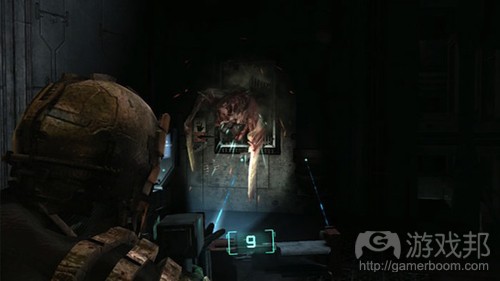
死亡空间(from gamasutra)

- 死亡空间(from gamasutra)
如此看来电子游戏的发展趋势便是更加突出一些本能行动(我们可以通过对比《死亡空间2》与《死亡空间》,或《生化危机4》和《生化危机5》与之前的《生化危机》系列),这就标志着开发者可以更好地基于恐怖游戏(而不是真正的恐怖游戏)创造出一款动作游戏,并有效体现出我们上述所提到的所有动物行为原则。
结论
作为一名神经系统科学家,我很高兴看到电子游戏能够有效地利用科学原理,并且我也发现了这种趋势将持续吸引更多游戏玩家。所以,我们到底能从《失忆症》,《寂静岭》以及《F.E.A.R.》等游戏中学到什么?也就是说,我们该如何将这些基本的神经学原理应用于电子游戏中?
首先我们需要做的便是保持消息的灵通。科学研究的进展总是非常快速,而大多数研究结果却只能在(至少)10年后才真正被大众多了解——即最终发布在教科书上。而最近关于信息交流的改革却也不能完全解决这一问题,所以我们能说这种改革是一把双刃剑。它既能够帮助我们快速传播信息,但同时也仍是一种不可靠的方法。
然后便是需要大胆地尝试各种新类型。通常,新游戏的出现也会伴随着我们对于电子游戏的新认识。尽管这种方法风险重重,但是在这个充满各种游戏的产业中,遵循一个明确且统一的方法非常重要。
最后,我们必须建立起游戏(或者说是主要角色)与玩家间的情感联系。角色扮演游戏便通过模糊了玩家与角色间的界限而有效地呈现出这种情感联系。而在其它非角色扮演游戏中,这种联系便不那么明显了。
建立玩家与游戏间的纽带的最佳方法便是诱发玩家产生强烈的情感。恐怖求生游戏便是利用恐惧感而有效地做到了这一点。但是这却不是唯一方式。最近我们还看到一系列不同的游戏在利用各种不同的情感,如悲痛( Tale of Tales的《墓地》),爱与失去(Thechineseroom的《Dear Esther》)等。显然,“一体适用”的电子游戏时代已经一去不复返了。
最后,我们必须在面向玩家销售游戏前先了解他们。游戏产业中有许许多多游戏工作室,而不管他们开发的是AAA游戏还是独立游戏,肯定没有一个开发者想要冒险创造出一款不可能成功的游戏。所以了解玩家对于吸引人/刺激/上瘾的定义有助于他们创造出真正成功的电子游戏。
篇目6,恐怖游戏应给予玩家力量并引发其恐惧感
之前我曾探讨过游戏中的恐怖设计,如为什么游戏中的“抵抗或逃跑”反应应该“势均力敌”。《战锤40K:星际战士》最近发布了,让我想起以战锤世界为背景的另一款游戏——《太空战舰:铁血天使的复仇》。我认为这款游戏能告诉我们如何在给予玩家力量的同时引发他们的恐惧,是一个经典案例。由此,我想出了以下几条建议。
1、玩家必须始终能够反击
虽然我将《失忆症:黑暗后裔》当作冒险游戏来玩,我认为这款游戏不恐怖的原因之一是:玩家无法自我防御。
回到我以前写的一篇文章,抵抗或逃跑反应是人类的本能,因为我们的大脑必须遭遇危险的情况下快速决定留下来抵抗或逃走,此时大脑会释放相应的神经递质。当你移除这种反应的其中一半时,玩家的选择就受限了。在《失忆症》中,当我被怪物抓到时,我从来不逃走,任凭它杀掉我,因为我大不了重来一次。相比于重来,逃跑要做的事情更棘手。
如果存在抵抗和逃跑的选项,玩家就不得不作决定了。在这一点上,《Alan Wake》做得比较成功:在游戏中,玩家不断地被敌人包围,迫使玩家决定把敌人打倒还是逃向下一个安全区域。
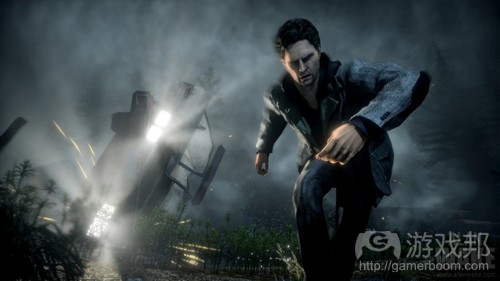
Alan Wake(from kotaku.com.au)
另一方面,游戏允许玩家反击,但只能在特定的时间。在《Haunting Ground》中,大多数时候,玩家会被一群要杀死他而不是伤害他的敌人追赶。在每个区域的尽头都有一个BOSS,玩家不得不想办法打倒它。
问题是,这种游戏在每一次危险来临时仅为玩家限定一种反应。在冒险过程中逃跑,在BOSS战中反击。为了让这种反应管用,玩家必须在任何时候都有这两种选择,如果你把玩家和BOSS锁在一间房里,那么这游戏就不再是恐怖游戏了,而是动作游戏,因为玩家知道自己唯有拼死一战。
在《太空战舰》中的常规剧情是,玩家是血天使的一分子,而血天使是一个太空战团,其任务是防止外星人占领地球。在游戏中,玩家的主要敌人是基因偷窃者,这种外星人用自己的基因传染给人类,使人类变成他们的同类。阅读了写在指南上的基本剧情后,我们知道太空战士是会接受任何挑战,无论挑战多么致命也要抗争到底。
偷窃者的数量总是多于玩家和小队成员,他们必须决定什么何时移动、停留和抗击。虽然有整队成员作为后援,幸存玩家一人并不难,但要让所有人活着回来就是另一回事了。
2、敌人的等级必须与玩家不同
恐惧的基本原则之一是,经历某些不习惯的事。虽然恐怖游戏在一定程度上做到了,比如怪异的怪物设计,但许多没有切中要点:敌人的战斗方式不应该与玩家相同。
在《战争机器》和《死亡空间》中,主线都是主人公用先进的武器与异世界的敌人战斗,但为什么前者被当作动作游戏,而后者是恐怖游戏?区别在于,在《战争机器》中,大多数敌人的战斗方式与玩家一样,都是打枪或扔手榴弹。而在《死亡空间》中,敌人与玩家是完全不同的,无论是进攻还是击杀方法。对于《死亡空间》中的怪物,玩家必须分离他们的肢体,否则肢体还会从被枪击的身体或头部重生。
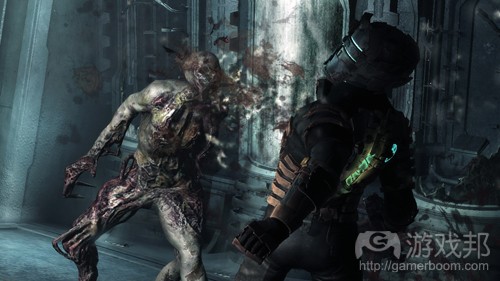
死亡空间2(from g4tv.com)
在《太空战舰》中,玩家的小队全副武装,用先进的武器抗击敌人。战队的标准配备包括一把狙击枪和一副用于近身战的能量手套。作为战士,他们有远攻的优势,且在与基因偷窃者的一对一近身战中,他们也会赢。
另一方面,偷窃者在近身战中表现更为快速灵活,因为他们的的爪子很强悍。如果他们从背后偷袭,战士还来不及回头就会毙命。偷窃者可以爬过通风口出现在军团的背后,即使用上了运动检测器,玩家也得时刻警惕。最后,偷窃者最危险的优势是,在许多关卡中,他们的数量总是比战士多,而且会无限产生。
《太空战舰》中的平衡是不对称的,双方是完全不同的,玩家反应和战斗的方式也与敌人不同。再说《Fatal Frame 3》,玩家与敌人战斗时不断处于劣势,因为敌人可以消失、重现,可以穿过墙壁、地板和天花板攻击玩家。
我玩《寂静岭》系列时遇到的一个问题是,虽然怪物设计得很独特,但大多数敌人都遵循相仿的进攻模式:接近然后伤害。因为玩家的主要武器是近距的,所以双方的交互作用也是类似的(《寂静岭2》中的锥头怪是例外》。
3、应该避免线性模式
最阻碍恐惧产生的方式就是线性攻击,因为一旦玩家知道游戏是按这种方式设置的,就不会再感到紧张了。
至于《F.E.A.R》,这款游戏在动作和恐怖这两部分是分离的。在动作部分,玩家被敌人攻击,处于恐惧中,他们徘徊着,没有意识到可怕的事正在酝酿。问题是,在动作部分没有任何可怕的事发生,而在恐怖部分没有出现任何危险(直到游戏的非常后面)。当游戏试图吓倒我时,我不但不害怕,反而觉得更放松了,因为我知道我还没到危险关头。
如果可以让玩家去猜测,如下一波进攻是什么时候,玩家会感觉到更紧张害怕。原因是,玩家会不断地想到“我什么时候会被攻击?”。这种逐渐积聚的过程是恐惧感的绝妙来源,但是,当玩家最终受到攻击时,应该有一个中断点。如果玩家在整个阶段都完全没有受到攻击,那么这个逐渐聚积的过程就白费了。
在《太空战舰》中,可以让玩家意识到危险的唯一工具就是运动感应器。与电影《异型》类似,当有危险逼近时,这种工具就会发出哔哔声。而在《太空战舰》中,感应器有时候会出现失误,有时候玩家得自己提高警惕。这就维持了玩家的紧张感,因为玩家不知道什么时候下一波攻击会来袭,只知道危险正在逼近。
为了让恐怖游戏摆脱我个人认为的惯例,必须借鉴rogue类游戏的做法,并随机分布敌人的位置及进攻方式。怪物越快从群体中冲出来,游戏就越恐怖。我还希望怪物不总是进攻玩家,就像在《太空战舰》中,玩家会因此疑惑目前情况的安危。
4、敌人与玩家一起成长
玩家变得更强大后,会觉得更有安全感,这就减少了对游戏的紧张感,因为原来无法通关的地方,现在可以回头再闯了。恐怖游戏在这里出现的问题是,忘了恢复玩家的紧张感,最好的解决办法是,敌人也跟着变强。
《Alan Wake》也存在这个问题,随着游戏进展,玩家会得到更多类型的武器和手榴弹,然而敌人从来没变。有些敌人可能需要更多光才会被削弱,但这个过程从游戏开始到结束都是一样的。
在《死亡空间》中,玩家会得到新的武器和装备,设计师也确实引入了新敌人挑战玩家,包括两次与只会受伤不会被杀死的敌人战斗。、
在《寂静岭2》中,玩家遭遇锥形头怪物的时刻非常可怕,因为这个怪物与玩家战斗过的普通敌人不同。当锥形头怪物挥舞巨大的剑时,玩家一接近就是自找死路,这就迫使玩家从远处开始反击或逃跑。
在《太空战舰》中,玩家会因为获得新武器而变强,包括一种有助于近战的武器。随着游戏进展,玩家会与新类型的基因偷窃者作战,还有暴走的战士,他们是玩家的邪恶版本。之后,敌人的类型包括能进行超能力攻击的偷窃者,如心灵之火或让玩家的武器失灵。当玩家变得更强大,敌人也有自己的增强方式,由此达到敌我双方的平衡。
如果玩家不进步,敌人也不必变强,这一点很重要。在《Fatal Frame》系列中,玩家由始至终都是用相机作为唯一的防御工具。相机可以升级得更有破坏力,但相应地,敌人的命值也会变长。后来的敌人确实有不同的进攻模式,但玩家的防御方式保持不变。
5、给予玩家喘气时间
再返回用随机进攻模式保持玩家的紧张感,游戏中应该总是存在一段轻松或安全的时期。原因是,如果玩家总是被恐惧感轰炸,他们会对险境变得麻木。即使我认为《失忆症》不够恐怖,但我确实很欣赏设计师让玩家有安全时期的设定,玩家在这段时间内可以专心解谜或什么事也不干。
当然,给玩家一段安全时期也可能起到反效果。《Fatal Frame 3》中最恐怖的时刻之一是,游戏进行时,安全时间就像沙漏一样慢慢流逝,我不想在多说,怕坏了感觉。
如果你想让玩家想出正在发生什么事或作出重大决定,就必须给玩家时间处理游戏中的事件,而在这段时间内,玩家不应该疲于奔命或与怪物战斗。
《太空战舰》的处理手法很巧妙。一旦到了玩家给小队成员下达指令的时候,玩家可以暂停,以查看区域地图和完成发令。屏幕下方有一个仪表,会慢慢地缩短,表示当前冻结的时间,玩家可以在这段安全时间内思考和发号施令。一旦仪表走完,敌人就开始进攻了。玩家正控制着角色时,仪表会再次恢复,让玩家有更多时间思考。
我们都会不同程度地感觉到恐惧,这只是人类的本能。然而,我认为恐惧的入口是重点,会吓倒所有玩家。我的设计目标之一是,制作一款游戏,玩家有各种各样的武器:散弹枪、火箭筒、喷火器等,但是玩家仍然会因为黑暗和未知而感到毛骨悚然。
篇目7,无助感和氛围是当代恐怖游戏重要元素
恐怖电子游戏还在继续发展着。我们曾经以为不断发展的行动类游戏,如《生化危机》已经算是恐怖游戏的顶峰了,但是真正的恐怖游戏应该是充斥着恐惧与紧张感,以及我们难以避开的一些潜伏元素。
Capcom制作人Masachika Kawata在今年早些时候曾经说道,虽然老式的恐怖游戏还是没有多大的市场(比起恐怖游戏玩家更喜欢行动游戏),但是自从2010年《失忆症:黑暗后裔》取得了巨大的成功及其续作的各种宣传都表明恐怖游戏将再次崛起。
前几周出现了几款引人注意的恐怖游戏,它们通过使用完全不同的方式去传达这种游戏理念,并且未使用任何强烈的行动去诱发玩家的恐惧感。
以Slender Man神话为题材的《Slender》便是通过创造一种“崩溃”感而营造出恐怖氛围,它将玩家放置在一片树林繁茂地区,让玩家觉得背后有个高大的巨人不断地追着他,但是玩家却没有任何防御武器。
与之相比,来自Dreampainters的《Anna》便是一款更加传统的冒险游戏,它围绕着意大利的一间锯木厂而展开。尽管玩家不会真正遭遇任何敌人,但是游戏却通过黑暗和音效制造出背后有东西在注视着玩家的感觉。
无助,不可预测性和氛围
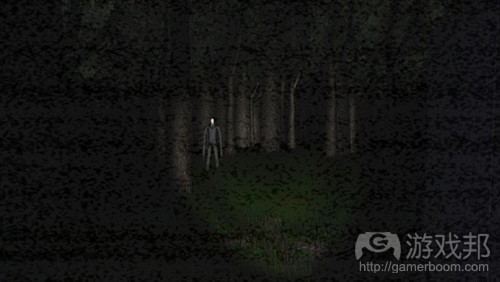
slender(from gamasutra)
《Slender》开发者Mark Hadley认为在恐怖游戏中营造出可怕氛围的元素很多,而最大的影响要素则是无助感。
“我认为身处无助的情境是任何游戏中最可怕的时刻,”他表示“《失忆症》在这一点便做得很好,而也正因为这一点它才成为我最喜欢的游戏之一。”
他补充道:“但是这并不意味着玩家能够反击时就会削弱恐惧元素。只要不是让玩家感到彻底崩溃和抓狂,适度的无助感便是一种有效的元素,这能够让玩家觉得自己还有一丝胜算。即使玩家可以进行反击,但只要其他元素也设置到位,游戏仍然不失恐怖感。”
Hadley认为不可预知性是诱发玩家恐惧感的另外一大要素。虽然能够最大化意外感的脚本元素设置得当时也能创造惊人效果,但它们却会违背冒险精神,并导致玩家丧失一些恐惧体验。
“游戏会随机在玩家周围安插某些元素而创造出各种不确定性。并且这种不确定性将始终伴随着玩家,以此制造出真正的恐惧感,”他强调道“这也是为何《求生之路》等游戏总是能够带给玩家恐怖感的真正原因——即使玩家在游戏中已经全副武装了;因为游戏中的随机性,玩家永远都不会知道不远处正有一辆坦克等着自己。”
同时他也表示这是《失忆症》中存在的一个问题——“玩家在一开始玩游戏时便能够感受到极其可怕的游戏体验,但是在此之后当玩家慢慢知道今后会出现什么时这种恐怖感也逐渐消失了。”
而脚本序列则意味着我们必须增加“跳跃元素”,即想办法让玩家感到惊讶而不是害怕。
“不要误会我,跳跃恐惧也有它的作用,但如果你的游戏只有跳跃恐惧的话,那它便不能算是恐怖游戏,”Hadley说道“如果你是一开始先创造一个恐怖的氛围并如此引出跳跃恐惧,那会更加有效。而如果你设置了合理的悬念,你便可以直接给为家营造出恐惧感了(且无需让他们感到惊吓)。”
氛围设置(游戏邦注:例如墙上的阴影投射或者未知的回音等)更是决定了一款恐怖游戏的成败,无论你是如何设置其它元素。
Hadley说道:“如果缺少了音效和视觉效果,恐怖游戏便不能有效运行。也就是说它们只是游戏的点缀品而非游戏本身。它们只能用于加强游戏的恐怖感,并不能完全取代游戏。”
“但是这并不意味着我们只能通过阴影和不祥的音乐去传达恐怖感;有时候沉寂也能营造出非常有效的惊悚氛围。”
恐惧来自恐惧本身
Dreampainters游戏设计师Simone Tagliaferri非常清楚他们的团队希望创造出哪种感觉的《Anna》。该款游戏将背景设在意大利的Val d’Ayas,并且一开始的场景是在明亮的农村,玩家希望在此找回属于自己过去的记忆。
而当玩家进入一间锯木厂时,游戏便迅速笼罩了一层可怕的氛围,并且此时玩家耳边总是回荡着一个陌生女人的声音叫他离开。在场景设置中标记和信息也非常重要。
Tagliaferr表示:“我们尝试着将早前图像冒险游戏与现代心理恐怖游戏结合在一起。”
“我们并不想在屋子中放置怪物或其它敌人。在如此场景中设置这些角色并没有任何意义。老实说Anna并不想杀死主角,她只是想通过吓唬他而让他离开而已。锯木厂只是用来驱逐访客而已。”
《Anna》通过创造一些恐怖的氛围带给玩家恐惧感——而这也是电子游戏还未真正涉及到的理念。
Tagliaferr也提到《失忆症》对于他们团队在开发《Anna》时带来了一定的影响,他们同样也使用了图像冒险游戏系列中常出现的黑暗布景。
针对《生化危机》等动作恐怖游戏他则认为,单单从动作游戏角度来看,这些游戏都很出色,但是如果说到恐怖感,它们则远不如冒险游戏。
他说道:“在玩《生化危机5》时玩家唯一要做的便是考虑如何杀死敌人——但是他们却不会害怕这些敌人。玩家在此与《使命召唤》中的一般士兵没多大区别。”
篇目8,阐述恐怖游戏增强恐惧感可用的四个方法
近年来,恐怖游戏看似成了动作游戏与第一人称射击游戏崛起的大潮中,最为惨败的家庭主机游戏类型。在只关于直面危境和快速反应的游戏中,要唤起玩家的恐惧感颇有难度。当然,这不是不可能,要做到这一点,恐怖美学胜过其他大多数方法。
日本游戏行业的萎缩也影响了恐怖游戏的惊悚程度和基调,因为东方文化和欧美文化之间的显著区别,二者处理恐怖的态度也不同。
可以说,欧美媒体在表现恐怖的方式上,比较直接和浅显:往往有一个观众心知肚明的敌人,但故事中的角色却浑然不觉(这就是为什么我们喜欢徒劳地提醒健忘的电影主角——不要打开那扇门!)我们总是知道为什么拿斧头的凶手会变成疯子,或者什么是罪恶之源。观看大多数欧美作品时,我们的恐惧感通常来自强烈的视觉表象或者会对角色的身体造成伤害的威胁。
而日本和韩国的恐怖媒体往往根据未知的或未解的主题制造恐怖,如家族秘史、鬼怪奇谭和民间传说就比暴力和血腥的题材更流行。在现代主机游戏中,最恐怖的游戏如《生化危机》、《寂静岭》和《零系列》等等,都出自日本制作人之手。
而现在,在追求西化的过程中,当下流行的作品似乎缺失了某些东西。《生化危机》还是像以前一样热门,但曾经带给玩家探索鬼宅和寻找宝贵资源的恐怖体验,开始变成活泼的动作游戏。现在,玩家的主要活动是,操作身强力壮的角色屠杀成群结队的僵尸。
玩家对每一款新的《寂静岭》游戏的接受度都比上一款更差,即便科乐美那么认真地模仿使先前游戏富有新意的东西。
另一个使恐怖游戏衰弱的原因是,PC游戏文化改变了:点击式益智游戏和探索游戏曾是90年代末和2000年初的市场主流类型,过去我们熟知的冒险游戏现在也式微了。冒险游戏才刚开始探索更加黑暗、更加恐怖的主题(其是否成功尚有争议),如《7th Guest》和《Phantasmagoria》,市场又变了。
所幸的是,对于恐怖游戏粉丝,今天的PC游戏的商业模式的改变意味着冒险游戏和剧情游戏有望复兴。可下载的和独立游戏是游戏产业中的一股强大力量,其质量提升更加迅速,除了对新型体验的探索热情更加高涨,行业还从那些我们一度全盘否定掉的游戏形式中回炉某些设计。
结果是,兴盛的独立制作的恐怖游戏越来越高调;最近的《家》向我们曾经喜欢的剧情导向型恐怖游戏致敬,得到了不少用户的好评和关注。令人恐惧的《Slender》起源于“creepypasta”(游戏邦注:“creepypasta”是一个专门收集流传于网上的恐怖故事、图片等的网站),支持用户免费玩游戏(这个题材特别吸引人,因为它意味着玩家的恐惧来源不仅有历史或旧电影中的怪物,还有现代传说,比较新鲜)。
还有一些在商业性更明显的成功的游戏案例,证明人们仍然希望吓倒自己的不只是外星人和枪支:人人都爱《失忆症:黑暗血统》,《Limbo》的惊悚冷酷的美学使它大受欢迎。这样的案例不胜枚举。
制造恐惧的四个方法
如何把游戏做得真正令人恐惧,这是个有趣的思考题,特别是因为产生恐怖的公式似乎不那么确定且容易出错,如果你看看玩家感到可怕的游戏类型的比率,你就知道了。因为恐怖游戏似乎有复兴的趋势,让我们看看让玩家产生恐惧感的技术。我们都知道环境音效很重要,也明白资源和武器的稀缺会使玩家感到更脆弱。但以下四点可能是你没有考虑过的:
模糊性。为了给玩家带来满意的体验,明确的目标和实现目标的方法是关键;而模糊性恰恰从未成为游戏的流行特征。但在恐怖游戏中,毫无疑问,它可以唤起玩家的想象;你可以借助视觉和声音线索或重要的信息点,引导玩家游戏。
但想想是什么让观众迷上恐怖电影:他们希望找出恐怖事件的始作俑者和原因,他们想看看主角能否生还。当玩家的视线长不过手电桶的光线,那就是恐怖;当玩家不能确定自己能否信任叙述者,那就是恐怖。当你能够做到以上效果,玩家就不能信任他们看到的东西,就会产生了精神上的不安。这就是开启恐惧的钥匙。
对玩家隐瞒某些信息,有助于玩家产生恐惧感。《寂静岭2》就是运用模糊性的绝佳案例。游戏一开始不会向玩家透露任何事,但玩家始终准确地预感到有什么不好的事正在发生,而主人公却不能察觉。
场所。恐怖游戏中经常出现的场所有很多。在某个地方,某人发现了某些非常可怕的事,这已经成了标准套路。所幸的是,这些隐喻确实可以运用得很好;即使“恐怖医院”已经被反复用到滥,它仍然管用,因为当玩家看到某个“恐怖医院”时,他们会立即明白自己身处险境。
旅馆、监狱、学校和大楼也时常在恐怖媒体中露面,因为这些地方的墙壁里往往隐藏着古老的遗迹。对恐怖游戏开发者来说,知道为什么这些场所管用,并且能够良好地运用具有文化普遍性的“恐怖场所”,这一点甚为重要。但最让我心惊肉跳的游戏常会使用场所颠覆玩家的期待。例如,如果游戏先引导玩家相信自己的家、卧室或其他经常去的地方是安全的,之后却在这些场所制造一些恐怖事件,这样玩家的恐惧感就会更强烈。
《寂静岭》经常使用某一类场景——荒废的公寓、残破的医院和大雾迷漫的街道。这些在游戏中常见的地方并没有让玩家产生视觉疲劳,反而增强了恐怖感。而《寂静岭4》给玩家一个可以离开也可以返回的场所。随着游戏进行,玩家的安全港湾变得越来越脆弱,越来越不能抵挡入侵。给玩家制造绝对的个人空间,然后颠覆玩家的期待,这是吓倒玩家的好办法。
与主人公的关系。在恐怖游戏中,让玩家对自己的角色产生某种情绪非常必要;玩家与角色的关系应该与同情有关。如果玩家同情主角,那么他们就会担忧角色的安危,当角色发生什么事时,玩家就会感到害怕。或者,他们会将自己带入那个场景,通过角色的经历更加深刻地体会到那种恐怖。
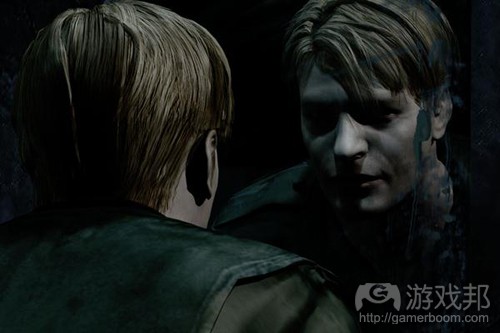
寂静岭(from gamasutra)
但有时候,其他关系可能会使玩家更加惊讶和不安。2005年的《Haunting Ground》将玩家设定为一个手无缚鸡之力,却要摆脱敌人的年轻女孩,如果她的处境变得太过严峻,她就会陷入难以抑制的恐慌之中。
女孩困在城堡中,和她一起的还有一些想要利用她身体的可怕炼金术士。她不是人人都想扮演的角色,游戏对待她的方式让人感到非常不舒服。然而在《Haunting Ground》中,这种设定让游戏的恐怖效果更强,因为在主人公所处的情境中,玩家常常要承受重大压力、不适和不安。这表现了设计师的深思熟虑和意图,是游戏对待弱女的惯用手法,但却往往被遗忘。
氛围的微妙变化。除了颠覆玩家对场所的期待和创造玩家与主人公之间的意外的关系,还有另一种方法可以捉弄玩家的感觉。传统的恐怖游戏粉丝热衷于探索,且似乎喜欢游戏奖励他们对细节的关注。当他们习以为常的事物改变了,或当他们周围的环境受到干扰,都能激起玩家的好奇心,增强他们的恐惧感。
《Phantasmagoria》这款游戏算是Sierra于90年代做的一个奇异实验,是用当时最好的技术创造一款成熟的、成人恐怖游戏。这是第一款使用真人演员作为玩家角色的游戏。这款游戏确实野心勃勃,娱乐了也吓倒了当时的许多玩家——它是冒险游戏转型时的遗产之作。
随着剧情的进展,该游戏世界的演变方式仍然是个有趣的例子,证明了氛围的改变可以唤起玩家的恐惧感。在《Phantasmagoria》中,玩家要探索一座曾属于一位阴险的魔法师的大宅,这位魔法师还留下了大量遗产。然而,随着章节进行,氛围变得越来越诡异;玩家在游戏中可以看到一个古怪的自动占卜机,它带来的信息越来越不祥,发出的音乐旋律也渐渐由愉快转向阴暗。
已故魔法师的香烟和酒好像莫名其妙地、一点儿一点儿地消失了。玩家的电脑显示的提示越来越混乱。甚至连音乐也改变了,令人不安的音调渐渐变得沉重——之后,甚至好像是演奏音乐的人出错了。
对于整个过程都发生同一间屋子里的游戏来说,非常有必要在重要的探索活动中注入了一种恐怖的气氛。因为这让玩家感觉不到自己对环境的掌控感,当然就更易心生恐惧了。
篇目5,篇目6,篇目7,篇目8(本文由游戏邦编译,转载请注明来源,或咨询微信zhengjintiao)
篇目5,Fight or Flight: The Neuroscience of Survival Horror
by Maral Tajerian
Fear is one of the most primitive instincts in humans. Although it has been particularly useful in keeping us alive in dangerous situations, it has also helped the entertainment industry capitalize on our sheer joy of being scared. The video game industry has done a good amount of scaring by taking advantage of these emotions and employing them in gameplay narrative and design.
This practice is best exemplified by putting the player in a vulnerable situation with limited resources to confront enemies. With proper execution, the genre can make your heart race, palms sweat and make you go to sleep with nightmares. However, when executed poorly, players feel as if they’re simply “going through the motions”.
Over the last two decades, several games (ranging from the early Resident Evil series to the more recent Amnesia: The Dark Descent) have defined the survival horror genre by successfully engaging fear and anxiety in players.
Although successful iterations of these games offer different enemies, gameplay mechanics and plot, they all share similar ways of handling the human psyche. This article will discuss how fear as an emotion has been employed in the gaming industry and discuss how the balance between scares and gameplay can lead to success or failure.
The Science of Terror
Anxiety. Next to fear, anxiety is perhaps the most prominent feeling experienced in video games. Unlike fear, which is a response to an imminent threat, anxiety is a response to a future potential threat.
When perceptual systems are taxed, research has shown that a looming threat results in anxiety that heightens attention and increases sensitivity to potential dangers. This implies that solving a puzzle the character is presented with in the game does not take away from the experience of fear and danger. In fact, according to many gamers, solving the puzzles under dangerous circumstances only increases the feelings of fear. Consider how riddles and puzzles in Silent Hill excel in this respect.
An example of a puzzle from Silent Hill 2 that needs to be solved in a dark and dilapidated room.
While games like first person shooters are notorious for desensitizing players to violence, games that raise the player’s anxiety actually sensitize them to danger. This is simply how animals behave, and it’s a highly adaptive behavior, since it keeps individuals on their toes in anxiety-causing environments. Raising the levels of anxiety in a video game will therefore ensure that the player is sensitized to the danger in the game. In a game like Amnesia, the entire experience teeters on anxiety created up to confrontation with an enemy since the player has absolutely no means to defend himself.
Helplessness. As mentioned earlier, players in the survival horror genre are often faced with terrifying and inescapable circumstances, with little means of self-defense. In other words, they are truly and utterly helpless.
In Amnesia, some may remember locking themselves in a closet, or hiding in a corner staring at a blank wall for several minutes, because you’re convinced that if you move, even an inch, a certain and horrible death will soon ensue. Furthermore, elements like rigid camera angles, awkward control schemes (Silent Hill, and Early Resident Evil titles), lighting (Alan Wake, Dead Space), etc. all serve to obliterate what little control the player might have thought she possessed.
Helplessness is truly a powerful feeling. Studies have shown that animals that are faced with situations where they’re helpless develop strong feelings of fear and anxiety. This is also true in the case of humans. You may remember this feeling from your last visit to the dentist. Whenever you experience feelings of helpless and loss of control, you are bound to feel more anxious and fearful. The same stays true in video games.
Priming. In psychology, priming is defined as the effect in which the response to a stimulus is influenced by the exposure to a previous stimulus.
Consider the word-stem completion task, for example. Here, a test subject is exposed to certain words, one of which is the word “lettuce”. He is then asked to complete the following word: “let—-”. The effect of priming can be seen when the subject fills the blank with “tuce” due to the fact that he was exposed to that word earlier in the experiment.
Several games rely heavily on creating anxiety using this strategy, by using sounds that remind the player of an encroaching yet unseen enemy. In Amnesia, visits to various torture chambers (where he actually “hears” victims in an iron maiden, a brazing bull, etc.) leads up to being locked in a cell. The fact that such priming took place (being exposed to the torture scenes) clearly influences the way the player feels when he himself is locked up and dreading the possibility of similar tortures.
A diagram in the Strappado torture room in Amnesia: The Dark Descent.
In addition to this priming, certain events characterized by unexpected novelty can, very efficiently, startle a player. For example, events that can lead a player through a relatively safe part of a level may lower our guard to new threats when revisiting the same environment (i.e.: consider the first 30 minutes of Doom 3 or the hubs in the Silent Hill and Dead Space series).
These choices will often save time in level design while still maintaining progress and the required ambience to startle and terrify.
Mirror Neurons. Mirror neurons are neurons in certain regions of the brain that are active when an animal performs an action, or observes another individual performing that same action.
Discovered a few decades ago, these neurons are argued to be the key in understanding other individuals’ intentions and feelings, empathy, and even imitating the actions of others. It is very possible that mirror neurons play an important role interfacing our experiences with a virtual avatar.
PET studies highlighting similar clusters in the brain that activate between individuals who are watching an action (listening to music) or partaking in an action (playing music).
In most video games, moving in a three dimensional space is likely to trigger spatial orientation mirror neurons. In the Silent Hill series, similar mechanisms would elicit anxiety and disgust when players are given the choice to stick their hand into a hole in a wall or to take something out of a toilet.
James Sunderland from Silent Hill 2 asked to stick his hand in a dirty toilet, likely eliciting disgust in the player, who mirrors this experience in her own brain and, to some extent, “experiences” it herself.
Similarly the same can be said in Dead Space 2, where players are given the choice to crawl in very confined spaces (where the right camera angle make the entire difference) or guide a needle into the eye of Isaac Clarke.
And what’s best is that the developers of these games are increasingly aware of these facts and capitalize on it. As Thomas Grip of Frictional Games (Amnesia: The Dark Descent) himself said at the Games Colloquium at Concordia University last year, the involvement of mirror neurons is important when the empathy factor is high. In other words, you can’t help but put yourself in the protagonist’s shoes.
Context and Environment. Naturally, our environment plays a large role in the perception of fear and potentiating startle responses. In the right context and environment, our baseline startle reflex shows gradual elevation over the course of aversive conditioning (antagonizing the player).
This works both inside and outside the game. Out of the game, mood plays a large role in getting the most out of the experience (consider the importance of playing in a dark room, adjusting the gamma, and wearing headphones). Creating the right environment inside of the game is equally important and capitalizes off of our own neurobiology. For example, our fear of the dark stems from our evolved circadian rhythms that revolve around a diurnal (day-night) cycle making us vulnerable at night. Similarly nocturnal animals like rats exhibit very similar startle responses, only in the light.
The use of light has always created a sense of helplessness and a shrouded and mysterious environment creating ambience in the survival horror genre. Alan Wake (top) and Dead Space 2 (bottom).
It should be noted that the appropriate context can also elicit fear in not so dangerous objects or cues. Fear conditioning with auditory cues can still cause anxiety, with the auditory cue and no immediate aversive stimuli.
An example of this is best exemplified by F.E.A.R.’s antagonist Alma, a little girl who can do rather terrible things. Additionally the unpredictability of aversive stimuli (such as a little girl vs. a man with a chainsaw) increases our perceived anxiety and fear.
In the case of F.E.A.R., game designer Craig Hubbard said that “…a guy in a mask chasing co-eds with a meat cleaver can be scary, but on some level you’re thinking to yourself, you could probably kick his ass if you got the drop on him… But when a spooky little girl takes out an entire Delta Force squad, how are you supposed to deal with that?”
Integrating Terror into Gameplay
Achieving scares and interactivity in the horror genre is no easy feat. Whereas other games challenge the player’s ability to solve a puzzle or take down an array of enemies, the survival horror genre challenges a hardwired and highly adaptive response to threats. To establish one good startle, you need to take into account the ability for your design to establish a baseline of expectations with your environment and the purpose of your character in that environment, build anxiety, connect with the character, and remove any control the player may have (consider the importance of the first 10-15 minutes of Dead Space and the player’s first encounter with an enemy).
This design often leads to the scripted scare (i.e. Pyramid Head’s non-confrontational spooky/disturbing appearances scattered throughout Silent Hill 2), which can remind us of the linearity of gameplay and a lack of a personalized experience/choice and replay value.
Top: Dead Space’s first/scripted encounter with a necromorph does not give the player a chance to fight back, but removes control and increases anxiety. Bottom: Scripted moment with Pyramid Head omniously staring at James Sunderland through impenetrable bars.
This raises the additional challenge of creating unpredictable moments while playing. For example, in a game like Silent Hill: Shattered Memories, certain events can cue an “ice-world transition”, prepping the player to run in order to avoid danger.
The first time, such an event can create anxiety but not as much after the third or fourth. This does not mean that these events fail to create anxiety in the player, but they do not achieve it to the same degree due to our own learning of what a player must do in order to play/win.
Similarly in Dead Space, some players can plan their confrontations by prepping themselves to orient their attack to nearby vents or gratings. In fact, once they do, their experience with the game is not one of fear, but of confrontation and seizing power.
Top: Necromorph whack-a-mole in Dead Space. Bottom: Ice transitions in Silent Hill: Shattered Memories = run.
It seems that with the growing tendency of video games to move towards more visceral action/gore (Dead Space 2 vs Dead Space, or Resident Evil 4 and 5 vs Resident Evil 1 to 3) signals that it is easier to design an action game based off of a terror franchise instead of a true horror game that can succeed in the aforementioned principles of animal behavior.
Conclusions
As a neuroscientist, it is very rewarding for me to see science being used so elegantly in video games, and I can easily see this trend continue to appeal to an increasingly smart gaming audience. So, what can we learn from games like Amnesia, Silent Hill, F.E.A.R., etc.? And in more general terms, how can we implement basic principles of neuroscience into video games?
Clearly, the first step is to stay informed. Research in the sciences is extremely fast-paced, and most of the findings don’t reach the general audience until at least a decade later when they’re published in textbooks. The recent revolution in information exchange does not completely solve the problem and is a double-edged sword. It helps spread knowledge faster, but is often unreliable.
The second step is to be bold enough to experiment with new genres. Every now and then, a game comes along that creates a completely new way of thinking about video games. Although this is a risky approach, it is much needed in an industry that boasts literally hundreds of games that follow the exact same recipe.
Finally, it is important to form a solid emotional bond between the game (or the main character) and the player. RPGs do this beautifully by blurring the line between the gamer and his avatar. For non-RPGs, the task is less straightforward.
One of the ways to establish/strengthen the bond is to elicit very strong emotions in the gamer. Games in the survival horror do this using fear, which can be very effective. However, it is not the only way. We have recently seen an onslaught of different games that capitalize on a range of different emotions such as grief (Graveyard, Tale of Tales), love and loss (Dear Esther, Thechineseroom), etc. It is clearly evident that the era of “one size fits all” video games is long gone.
At the end of the day, it’s important to know your audience before you can sell them a product. With the abundance of game studios, whether it’s the triple-A industry or the budding indie games, no developer can risk making a game that will flop. Understanding what humans find engaging/stimulating/addictive is necessary in making a given video game a success.
篇目6,The Interplay of Fear and Power In Horror Games- Or, How To Make Manly Men Cry.
by Josh Bycer
We’re one month away from October, which can only mean one thing: discussing horror elements in games. In the past I’ve talked about horror design in games, such as examining why “Fight or Flight” needs to be around. With the recent release of Warhammer 40k: Space Marine, it reminded me of another game in the Warhammer universe. Space Hulk: Vengeance of the Blood Angels, which came out for the 3d0 in the 90s and as I thought about it, the game is an excellent example of how to do fear while giving the player power, which led me to thinking about the guidelines for how to do this.
1. Player Has To Fight Back At All Times:
While I enjoyed Amnesia: The Dark Decent as an adventure game, I don’t consider it scary for one reason: the player cannot defend themselves.
Going to back to an article I wrote awhile ago, the fight or flight response is part of human nature, as our brains have to make a split second decision in a dangerous situation to either stay and fight or run away and release the corresponding neurotransmitters. When you remove half the equation, it restricts the options the player has. In Amnesia, I didn’t even bother running away when I was caught by a monster because I could just let it kill me and try again. There was more work involved with running away then just retrying.
By having both fight and flight as available options, it forces the player to make that decision. This was one area where Alan Wake succeeded, as the player is constantly outnumbered by the enemies in the game, forcing the player to decide if they can take them on, or try to run to the next safe area.
Another side of this is games that allow the player to fight back, but only at specific times. In Haunting Ground, the player for the most part, is chased by an enemy who wants to kill them with no means to hurt them. At the end of each area there is an actual boss fight where the player has to find a way to put them down.
The problem with this is that the game is still exemplifying one response at a time. Flight during the adventure segments, and then fight at the boss fights. In order for the responses to work, the player must have both options available at all times, if you lock the player in a room with a boss, then it’s no longer a horror game but an action game as the player knows that their only option is to fight.
In Space Hulk, the general plot is that you part of the Blood Angels, a group of space marines whose task it is to keep aliens from taking over planets. In the game, your main foes are the genestealers, aliens who infect races with their DNA to cause their species to grow. From reading the basic plot that was in the manual, the space marines are the kind of people who take on any challenge no matter how suicidal and fight to the last man.
The player is always outnumbered by the stealers and with squad members persistent across maps, they have to decide when to keep moving, or when to stay and fight. While it is easy for the player to survive with a full squad as backup, getting everyone back alive is a completely different story.
2. Enemies Have To Fight At A Different Level Then the Player:
One of the basic rules of horror is that you should be experiencing something that you are not accustomed to. While horror games get this right to a degree with weird monster designs, many miss the point that enemies should not fight from the same rulebook as the player.
Tell me, why is it that Gears of War is considered an action title and Dead Space is a horror title, when both games have the protagonist fighting otherworldly enemies with advanced weaponry? The difference is that in Gears of War, the majority of the enemies fight the same way as the player, using guns and grenades. While in Dead Space, the enemies are completely different from the player, both in how they attack and how to kill them. With Dead Space, the monsters or necromorphs can only be killed by severing their limbs, as they will just regenerate from body or head shots.
In Space Hulk, the player’s squad is heavily armored and uses powerful weapons to stop their enemies. The marines’ standard load-out includes a ranged gun and a power glove for close quarters. As a marine, they have the advantage of ranged attacks, and in a one to one fight against the genestealers they will win.
The stealers on the other hand, are quicker and better at close quarters due to their powerful claws. If they attack a marine from behind, that marine is dead before he turns around. The stealers also move through vents and can appear behind the marine group, even with a motion detector the player has to be on the lookout. The last, and most dangerous advantage, is that the stealers will always outnumber the marines and in many levels, they will infinitely spawn.
As you can see, Space Marine is about asymmetrical balance, both sides are completely different and how the player reacts and fights, is not the same as the enemy. Going to Fatal Frame 3 for a second, the player is at a constant disadvantage when fighting ghosts, as they can disappear and reappear while going through walls, floors and ceilings to attack the player.
One problem I had with the Silent Hill series is that while the monster designs were unique, the majority of the enemies followed the same attack pattern: get in close to do damage. Since the player’s main weapons are close range, both interactions are similar (with the pyramid head fights of Silent Hill 2 the exception).
3. Linearity Should Be Avoided:
One of the biggest ways to remove horror in your games is to have linear attacks, as once the player knows that the game is setup this way, it removes the tension.
With F.E.A.R, the game is split between action and horror segments. During action, the player is attack by the enemies, while in horror; they wander around while creepy stuff happens. The problem is that nothing scary happens during the action segments, and there is no danger while the horror segments play out (until the very end of the game.) Instead of being scared, I was more relaxed while the game was trying to scare me as I knew I was in no immediate danger.
When you can make the players guess, as to when the next attack is, it increases the tension and horror. The reason is that constant feeling of “when am I going to be attack?”. That buildup is an excellent source of fear, but it has to have a breaking point when the player is finally attacked. If they go through an entire area and not be attacked at all, then the buildup was for nothing.
In Space Hulk, the player’s only way to tell that there is danger is their motion sensor. Similar to the movie Aliens, it beeps louder as something dangerous gets closer. With Space Hulk, there are times that the sensor will go off, and there won’t be an attack, other times the player will have to defend themselves. This keeps the tension high, as the player doesn’t know when the next attack is coming, only that there is one on the way.
In order for the horror genre to get out of its current rut in my opinion, it has to take a cue from rogue-likes and implement randomized enemy positions and attacks. The faster they move on from “monster closets”, the better for the genre. I would also like to play a horror game, where the enemies won’t always attack the player, like in Space Hulk, making the player question if this situation will turn dangerous.
4. If The Player Evolves, So Must the Enemies:
Becoming more powerful gives the player a feeling of security and can lower the tension of the game and can be used to provide the player with an area that is toned down as they can now fight back effectively. The problem with horror games is that they forget to ratchet the tension back up, and the best way to do that is to have the enemies evolve.
Alan Wake suffers from this, as the game goes on the player is introduced to more weapons and grenade types, however the enemies never change. Some enemies may require more light to weaken, but the process remains the same from beginning to end.
In Dead Space, the player will get new weapons and armor as the game progresses and the designers did implement new enemies to challenge the player, including two fights with an enemy who could only be wounded by their weapons, not killed.
The moments in Silent Hill 2, where the player encounters the pyramid head monsters are scary, as this is something different from the normal enemies the player fights. Getting up close to one is suicide when they start swinging their over-sized swords, forcing the player to either fight from afar, or run away.
As the player progresses in Space Hulk, they will be promoted with new weapons, including ones that grant the player an advantage in melee combat. As the game goes on, the player will fight new types of genestealers, along with chaos marines, which are the evil version of the player. Later enemy types include stealers who have psychic attacks, such as pyrokinesis, or making your weapons act up. The point is that while the player becomes more powerful, the enemy is growing in their own way to challenge the player.
It’s important to note for this category, that if the player doesn’t evolve then the enemy doesn’t have to. In the Fatal Frame series, the player will be using their camera as the only means to defend themselves from beginning to end. The camera can be upgraded to do more damage, but that coincides with fighting stronger ghosts that have more health. Later ghosts do have different attack patterns, but the way to defeat them remains the same.
5. Give the player downtime:
Going back to randomizing attacks to keep the player tense, there should always be a period of rest or safety to wind things down. The reason is that if the player is constantly being bombarded with horror, they’ll become desensitized to the situation. Even though I didn’t find Amnesia scary, I do appreciate the fact that the designers did give the player periods of safety, where they can focus on the puzzle solving and nothing else.
Of course giving the player a safe zone can be used against them at some point. One of the best moments of fear in Fatal Frame 3, was how the period of safety slowly trickled away as the game went on, I don’t want to say anymore as it would ruin the event.
If you want to challenge the player to figure out what is going on or make important decisions, they need time to process the events of the game, where they aren’t running for their lives or fighting against strange creatures.
Space Hulk has an interesting way of doing this. Once the player reaches the point where they can give squad members orders, they can use the pause screen to view a map of the area to accomplish this. A meter at the bottom of the screen slowly drains, representing that time is currently frozen, allowing the player to think and command in safety. Once the meter runs out, time starts again and the player will now have to command while enemies are attacking. As the player is controlling their character, the meter fills back up again allowing them more time to think.
We all have different degrees of fear, that’s just human nature. However, I think that the points in this entry can serve as a focal point, which will scare any player. One of my design goals is to create a game that gives the player all kinds of weapons: shotguns, rocket launchers, flamethrowers etc, and yet is still completely terrified of the dark and unknown. With that said if I do make that game at one point, I have one bit of advice for you: be afraid, be very afraid.
篇目7,A new age of survival horror games, thanks to indie developers
by Mike Rose
Horror in video games is constantly evolving. Where we may have once associated increasingly action-based franchises like Resident Evil as being the pinnacle of what horror games can offer, the dish of the day is now fear and tension: the idea that something may be lurking just around the corner that you cannot easily fend off.
Capcom producer Masachika Kawata said earlier this year that there simply isn’t a large enough market for the good old-fashioned “survival horror” angle and that players want action over terror. Yet the success of 2010′s Amnesia: The Dark Descent and the brewing hype for its sequel suggest otherwise.
The last few weeks have seen a couple of notable horror titles released, both of which explore the genre in completely different ways, yet both still manage to capture that sense of true fear without the use of high-octane action.
Slender, based on the Slender Man mythos that originated from the Something Awful forums, takes a ‘freak out’ approach to horror, putting the player in a position where they are being pursued by a tall figure through a wooded area, yet have no means of defending themselves.
In comparison, Anna from Dreampainters is a more traditional adventure game based in a real-life sawmill in Italy. While the player never actually encounters any enemies, darkness and sound are used to suggest that something or someone is always watching you.
Helplessness, unpredictability and atmosphere
Slender’s creator Mark Hadley believes there are a number of key elements to making a horror game the scariest it can be — the largest factor being the feeling of helplessness.
“I think being in a helpless situation definitely makes for scarier moments in any game,” he tells Gamasutra. “Amnesia did this very well, and it’s one of my favorites because of this.”
“That’s not to say being able to fight back removes some of the fear factor,” he adds. “Helplessness can always be a good element as long as it isn’t frustratingly overwhelming; it has to feel possible to win. Even if you can fight back, however, it can be scary if the rest of the elements fall into place.”
Hadley thinks unpredictability is another huge element in building up terror in players. While scripted elements can work wonders if placed in such a way that maximum surprise is achieved, they can always work against the grain of the adventure, causing the experience to lose some of its scare factor.
“Sometimes just causing elements to be shifted around randomly adds a bit of uncertainty that’s always present. And that kind of hangs over your head as you play, in order to really produce that sense of dread,” he notes. “That’s why games like Left 4 Dead, for example, can be scary even though you’re often armed to the teeth; you never know if there’s a Tank waiting around that next corner, thanks to the randomizing elements of the game.”
This, he argues, was one of the only issues that Amnesia had – “it’s a fantastically scary experience the first time you play, but after that it loses a lot of the dread since you know what’s coming.”
Scripted sequences also mean that you’re essentially ramping up the “jump factor,” startling them rather than scaring them.
“Jump scares have their place, don’t get me wrong, but if your game is nothing but jump scares, that’s not a horror game,” says Hadley. “If you create a creepy atmosphere first, you can lead up to a jump scare and it becomes a lot more effective. If you do the suspense right, you can even scare someone without startling them.”
The way in which a horror game tackles atmosphere, from shadows bouncing off the walls to eerie echoes originating from an unknown source, is the difference between a winning or losing formula, no matter how you’ve tackled other elements.
Says Hadley, “Without the right sound and visuals, it won’t work. That said, this should be the icing on the cake, not the cake itself. By that I mean, it’s meant to enhance the horror, not try to substitute it.
“That doesn’t mean that everything has to be drenched in shadow and ominous music; it’s surprising how effective a moment of silence can be, for instance.”
Fear through fear itself
Dreampainters’ Simone Tagliaferri had a clear picture of what his team was looking to accomplish with Anna. The game, set in Val d’Ayas, Italy, begins in a lush, bright rural setting, as the player looks to resurrect memories from their past.
This all quickly descends into madness once the player enters the sawmill, however, with an unknown, haunting female voice constantly trying to ward the player away. Symbolism and messages also play a huge part in setting the scene.
“We have tried to create a blend between an old graphic adventure and a modern psychological thriller,” notes Tagliaferr.
“We didn’t want to put monsters or other enemies inside the house. They are needless in a setting like this. To tell the truth, Anna doesn’t want to kill the main character: she wants to scare him enough to let him go away. The sawmill is designed to repel its visitors.”
Indeed, Anna works through the concept that some sort of terrified spirit is attempting to keep people away through terror — an idea that isn’t often explored in video games.
Tagliaferr also notes Amnesia as having an impact on how his team approached the development of Anna, while also citing the Darkness Within graphic adventure series.
As for action horror titles like Resident Evil, he says that these work well as action games, but in terms of horror, as they simply cannot offer the tension of adventure-based game.
“Playing with Resident Evil 5, you only have to think about how to kill enemies — You don’t fear them,” he says. “At least, no more than a generic soldier in Call of Duty.”
篇目8,our ways to make better horror games
by Leigh Alexander
Amid new opportunities for horror games, Gamasutra’s Leigh Alexander looks at four frightening concepts that go beyond hacking, slashing and shooting.
In recent years, the horror genre seems among the largest casualties of the rise of action games and first-person shooters in the home console space. It’s challenging to create fear in games that are all about head-on confrontation and quick reflexes. That’s not to say it can’t be done, but the aesthetic of the gruesome prevails above most other approaches.
The contraction of Japan’s game industry has affected the breadth and tone of the horror genre too, thanks to some clear differences between the ways Eastern and Western cultures each generally approach fear.
It’s safe to say that Western approaches to horror in media usually involve the direct and the seen: There is often a clear enemy known to audiences if not to the story’s characters (it’s why we like to yell futile instructions to oblivious film protagonists — don’t open that door!). We always learn why the axe murderer became crazed, or what the source of the demonic evil is. Most of the time, scares come from strong visual imagery or the threat of physical harm to the characters.
On the other hand, the horror media to come out of Japan and Korea tends to create dread from the unknown and the unexplained, and themes of family, ghosts and folklore are more popular than violence and gore. In the previous console generation, the most frightening games, like Resident Evil, Silent Hill or Fatal Frame, among others, all hailed from Japanese creators.
The franchises that thrive today seem to have lost a certain something in their pursuit of Westernization — Resident Evil remains as popular as ever, but what began as an eerie experience exploring haunted mansions and clinging to precious resources is now a spry action title where we watch over characters’ brawny shoulders as they mow down hordes of zombies.
Each new Silent Hill game is received more poorly than the last, even when developers try earnestly to imitate whatever certain something made Konami’s early titles so seminal.
Another factor in the diminishment of the horror genre is the way PC gaming culture has changed: The point-and-click puzzle and exploration games of the late ’90s and early millennium used to be the primary kind of experience on offer, and now the adventure game as we once knew it is all but gone. The adventure game space had just begun trying to explore darker, scarier themes (to debatable degrees of success) in games like 7th Guest or Phantasmagoria, when things seemed to take a left turn.
Fortunately for horror game fans, today’s changing business models on PC mean adventure and storytelling games have an opportunity for resurgence. Downloadable and independent games are serious forces in the industry, quality ratchets up ever more quickly and creatives are hungry to explore new kinds of experiences — or to revisit and reappropriate bits and pieces of design from game forms that we might have once been overly-eager to throw out whole.
The result is a thriving indie horror game scene that’s going less and less under the radar; recently Home, a creepy little homage to what we used to love about story-based horror, got praise and attention from a broad array of consumer outlets. The terrifying Slender emerged from internet “creepypasta” lore and is free to play (that one in particular is fascinating, because it suggests new figures of fear can emerge not from history or old film monsters, but from modern digital folklore).
And there’ve been more obvious commercial examples of game successes that prove people still want to be terrified by things other than aliens and guns: Everybody loves Amnesia: The Dark Descent, and it was Limbo’s spooky, ruthless aesthetic that made it popular. Examples are everywhere.
Four ways to horrify
It’s interesting to think about what makes games like these truly scary, especially since the formula for horror seems precarious and easy to get wrong, if you look at the rate at which fans feel worried about the genre. Since it seems horror games have an opportunity to thrive again, let’s look at techniques for creating fear in players. We know that environmental audio is essential, and it’s also fairly well-understood how scarcity of resources or weaponry makes players feel more vulnerable. But take note of four ideas you may not have considered:
Ambiguity. Clear goals and methods for measuring performance toward goals are key to giving your player a satisfying experience, and vagueness has rightly never been a particularly popular quality for games. But in horror, it’s the things left unsaid that engage the player’s imagination; you can direct the player clearly through visual and sound cues, or key bits of information.
But think of what keeps folks hooked on scary movies: They’re hoping to find out who’s responsible for a terrible event and why. They’re watching to see whether the hero survives. When a player can’t see further than what their flashlight illuminates, it’s scary. If a player isn’t sure whether he or she can trust a narrator, it’s scary. When you’re able to make it so the player can’t trust that some things are what they seem, it creates that sense of psychic unsettlement that’s key to fear.
And withholding some information from the player can help set up thrilling revelations later. Silent Hill 2 is an excellent example of the ambiguity principle working well — won’t spoil anything for you here, but the game is engaging because of the player’s persistent, accurate hunch that there’s something darker afoot than what the protagonist can acknowledge.
Strong sense of place. There are a wide range of locales frequently used in horror; somewhere along the line someone found something scary about it, and it became sort of standard. The cool thing about horror is that tropes can actually be used well; even though the “creepy hospital” has been done countless times across media for as long as anyone can remember, it still works, because when players sees certain “creepy hospital” visual cues, they understand immediately they’re in a dangerous place.
Hotels, prisons, schools and mansions frequently appear in scary media too, because of the fact they carry long legacies inside their walls. Knowing why each of these environments work and being able to use culturally-universal “scary places” to strong effect is important, but the games that have unnerved me the most are ones that use place to subvert expectations. For example, if the player is led to believe early on in a game that her home, bedroom or other regularly-visited place is safe, it’s more terrifying later when something about it changes.
The Silent Hill games regularly use the same kinds of locations — dilapidated apartments, hospitals and foggy streets — and somehow that seems to empower those places rather than create fatigue. But Silent Hill 4 gave the player a home to depart from and return to. As the game progresses, the player’s safe place grows increasingly vulnerable to invasion and unpredictable. Creating strongly-individual spaces for players and then manipulating expectations is a great way to unsettle them.
Relationship with protagonist. It’s especially essential in horror games that the player has some emotion toward the character he or she plays, and it’s easy to assume that the relationship you want to forge with the player involves empathy. If players feel for the hero, then they’ll fear for the character’s safety, and therefore they’ll get scared when anything might happen to that character. Or they’ll be able to project themselves into the situation, thereby feeling closer to it through the hero.
But sometimes other kinds of relationships can create more opportunities to surprise and unsettle the player. 2005′s Haunting Ground cast the player as a powerless young girl who could really only run from her aggressors, and who was prone to entering an ungovernable, heart-pounding panic if her circumstances became too demanding.
Trapped in a castle with some creepy alchemical types that wanted to use her body, she wasn’t the kind of character anyone would want to be, and the way the game treated her was incredibly uncomfortable. Yet in Haunting Ground’s case it made the game more frightening and gross, as the player often experienced profound distress, discomfort and unsettlement at the protagonist’s circumstances. It felt considered and intentional on the part of the designers, too, versus the oblivious way games often treat vulnerable women.
Subtle changes in atmosphere. There are other ways to play with players’ expectations than subverting sense of place or creating unexpected dynamics between player and protagonist. Traditional horror game fans love exploration, and seem to enjoy games that reward their attention to detail. When something routine they expect to find changes locations, or when the environment around them appears tampered-with, it both excites their curiosity and amplifies the fear.
Sierra’s Phantasmagoria is a bizarre 1990s experiment in creating a mature, adult horror game with the best technology of the time. It’s known as the first game to use a live actor as an on-screen player character. Incredibly ambitious, it frightened and entertained many in its day — now it holds up so poorly it’s silly, very much a relic from a weird left-turn for adventure games.
Still, the way the game world evolves as the story progresses is an interesting example of how atmosphere changes can evoke fear. The player has to explore a massive house that once belonged to a sinister magician, and much of his property remains behind. Yet each chapter things change; a whimsical fortune-telling machine the player can check becomes more forbidding, its merry tune a little darker each chapter.
The late magician’s cigarettes and alcohol seem to be inexplicably disappearing bit by bit. The player’s computer shows increasingly garbled warnings. Even the music changes, its apprehensive tone gradually evolving into a heavier tune — later on, it even sounds like whoever is ‘playing’ it is making mistakes.
This infuses the key act of exploration with a sense of dread, especially important in a game that all takes place in the same house. It’s because the player is never allowed to feel like he or she has mastered the environment, which would certainly lessen the fear.







































 闽公网安备35020302001549号
闽公网安备35020302001549号